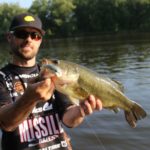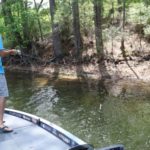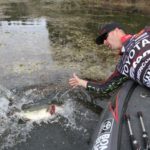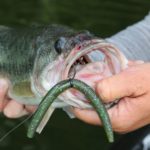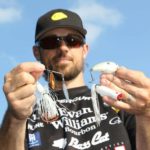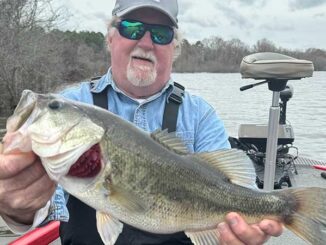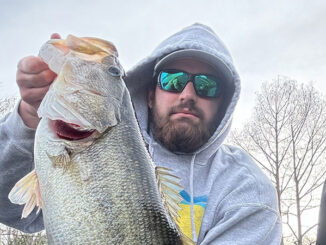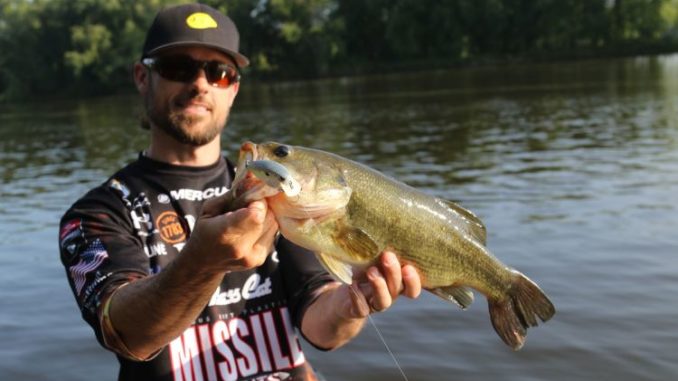
After a freezing winter and a wet spring, the spawn marches on at the Bend. Here’s the pros’ plan of attack in April.
To everything (turn, turn, turn).
There is a season (turn, turn, turn),
And a time to every purpose, under heaven.
It’s unclear if The Byrds were bass anglers, but their 1965 hit fairly summarizes the general shape of things on Toledo Bend. The spawn has been underway for some time now and, while it’s certainly not over, we’re definitely moving toward that finality.
The thing about this massive Sabine River reservoir we share with our Texas neighbors is that its length and significantly differing habitats promote a stratified spawning season. That means what has already happened in the shallow, darker upper end is probably trailing off in the mid region and likely upcoming in the deep, clear lower end.
“I’m going to be shifting my focus farther down the lake as time goes on, because the spawn happens north-to-south,” said FLW Southwestern pro Nick Lebrun. “You will have fish spawning all over the lake at once, but when it’s wrapping up toward the end (late April-May), I think that most of your fish that are still on beds are going to be on that lower-third of the lake.”
Bassmaster Elite Series pro Russ Lane agrees: “If you envision that lake heating up; what would be the last place to make it to that 57- to 58-degree mark — that would be the south end. It wouldn’t be in the pockets, it would be on the points in the mouths of the pockets.
“If it’s getting late in the spring and the water’s in the upper-60s and lower-70s everywhere, and you go to the riprap at the dam and that water is 57 degrees, there will be fish spawning on that riprap. That’s the last place where the conditions are right. You just have to envision how this body of water heats up and you can pattern the fish by doing that.”
Last call
Lebrun believes the key consideration for this final stage of the Toledo Bend spawn will be water level. After some soggy late-February rains, the lake was right at 172 feet.
“In years when the lake stays is low in April, sight fishing is going to be the main deal for those spawners,” he said. “If I’m in an area with a lot of good-sized spawners, I may try to get there early, right at daylight and do some blind casting.
“But I love looking at them; and if they’re big ones and they’re locked on, a lot of times sight fishing is the deal on that lake.”
While there’s a lot to be said for your natural colors like green pumpkin, as well as the bream-imitating black and blue, sight fishermen often find white is hard to beat. And not so much for its fish-fooling prowess — truth be told, bed fish don’t want any creature of any color anywhere near their bed. Rather, it’s simply a matter of observation advantage. When you’re staying back from a nervous bed fish, light refraction, clouds, etc. can make it tough to see the pick up. But white baits stand out clearly in most any scenario, so if you pitch into the bed and your white bait disappears, set the hook.
“I like a V&M J Bug and a lot of times, I’ll dye the legs chartreuse or red,” Lebrun said. “Sometimes, I’ll pinch off the bait’s upper two legs so it only has the bottom two flappers. I want to keep that bait compact because that gives the fish less to nip at.”
Another of Lebrun’s bed fishing strategies is to occasionally sub in a V&M Wild Craw Jr., a bait he described as having a lazy, irregular action, as opposed to the tighter look of the J Bug. The latter, he said, is his go-to, but when the fish play hard-to-get, a little variety can close the deal.
“Every bed fish is different and the larger they are, the more contrary they can be,” Lebrun said. “I don’t stress out trying to overthink it, but sometimes that fish wants that segmented, natural looking craw and he wants that lazier, more subtle action. He doesn’t want those legs moving all that much. Normally, I’d throw that Wild Craw Jr. when the fish won’t eat the J Bug.”
Now, when low light or vegetation conceals spawners, Lebrun often employs a tactic most experienced Toledo Bend anglers know as a fish locator. Run a soft body swimbait like the Reaction Innovations Skinny Dipper, YUM Pulse or Berkley Havoc Grass Pig, through likely areas and see who moves. If one bites, great, but even a swirl or follow tells you where to focus your efforts.
“A lot of that depends on the pressure the lake is getting,” Lebrun said. “If it’s on a Saturday and you’re in a 200-boat tournament and there’s a 300-boat high school tournament and it’s bright sun with no wind, a lot of times chunking and winding, or blind casting is just not going to work.
“But, if there’s not that much fishing pressure and you have some cloud cover and the wind’s blowing, that swimbait can work. Or I like to use a 6th Sense Movement 80x crankbait, which is a really good bream imitator. A lot of times, I like to throw that while I’m looking for bed fish so I can have two types of presentations.”
Late spawn habitats
As for late-season spawning habitats, Lebrun points to sparse hay grass. You don’t want it too thick, otherwise bass won’t spawn there because the sunlight can’t penetrate to warm their eggs. What you do want is a well-defined line, as the big fish seem to like this. Same goes for hydrilla — you want a clearly-defined inner line.
Lebrun’s also conscious of what areas hold the warmest and clearest water. Geography matters here, as your northern banks typically are the most attractive because they’re shielded from the chilly north winds of late-season cold snaps.
On the way out
After a wave of these late spawners does their thing, the exit march affords a whole new level of opportunity with postspawners stopping at the same types of places they staked out during their prespawn staging. Here, you’re looking for those points, creek channel ledges, stumps and laydowns between the spawning areas and the deep summer destinations.
Elite pro Jason Christie likens these postspawn areas of concentrated opportunity to convenience stores along the highways. If the spawning areas are local roads and the beds are individual driveways, you’re going to find your greatest concentrations at those common stopping areas along the major travel routes.
“Usually it’s all about the beam at that point and that makes you think of two things: a hollow-body frog in any kind of dark pattern and a wacky style worm like a V&M Chop Stick,” Lebrun said. “I may fish mine with a small (nail) weight and an O-ring.
“Also, if you have a windy, cloudy day, those postspawners will eat a moving bait like a Chatterbait or a squarebill. A lot of people like to throw topwater walking baits like a 6th Sense Dogma.”
Pointing to the golden hay grass as a popular postspawn hangout, Lebrun said he won’t hesitate to get aggressive with heavy tactics. Bass are bass and even an exhausted mother will react to sudden intrusions.
“I look for that sparse hay grass; the fish will get on the inside and the outside,” Lebrun said. “You may be looking at 4 feet on the outside and maybe 1-2 feet on the inside. I think the bass just use those lines of hay like a little highway and the fry will stay right on the edge.”
Note that this deal is dependent on whether the state sprays the hay grass. If not, then Lebrun will target those fry guarders by sending a craw bait with a 1 ½-ounce Elite Tungsten punch weight into the cover.
Watching the nursery
The natural extension of the postspawn is the emergence of the next generation — those clouds of ¼- to ½-inch long fry that hover around protective cover under the watchful eye of their papa. While spawned-out females rest and regain their lost weight on those postspawn rest areas, the males herd the young’ns to safety and aggressively drive off any potential threats.
This is the time to throw a variety of intrusive baits from topwater poppers to frogs, to swim jigs and even spinnerbaits. Lebrun also likes the wacky rig here, but you’ll also want to give a Texas-rigged stick bait a chance, as well. Great for casting, pitching, flipping and skipping, this versatile rig can do a lot this time of year.
With all of these strategies, think of the Toledo Bend spawn like a parade. If your seat’s at the start of the parade, you’ll see the floats and hear the marching bands first; but eventually, the fun moves past you. On the other hand, those at the end of the parade route have the action coming to them. But even here, the show only lasts so long.
That being said this is the time to take advantage of one of the best times of year to experience shallow water fireworks, so make it your purpose to bend a rod before this season turns, turns, turns ….
